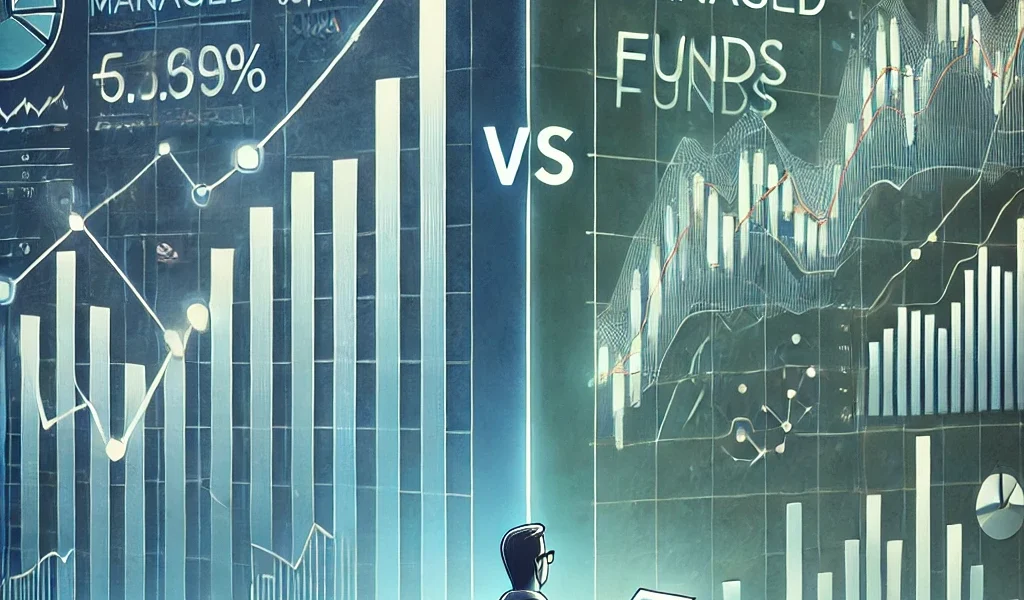Introduction
When investing in mutual funds, one of the biggest decisions investors face is whether to choose index funds or actively managed mutual funds. Both options offer unique benefits and risks, and selecting the right one depends on your investment goals, risk tolerance, and market outlook.
This article explores the differences between index funds and actively managed funds, their advantages and disadvantages, and how to determine which type is best suited for your financial portfolio.
What Are Index Funds?
Index funds are passively managed mutual funds or exchange-traded funds (ETFs) that aim to replicate the performance of a specific market index, such as the S&P 500, Nifty 50, or Sensex. These funds invest in the same stocks or assets as the chosen index, maintaining a similar proportion.
Advantages of Index Funds:
- Low Expense Ratios: Since index funds follow a preset market index, they require less management, reducing costs for investors.
- Diversification: Investing in an index fund provides exposure to a wide range of stocks, reducing risk.
- Consistent Performance: Historically, index funds have matched market returns over the long term, making them reliable for wealth accumulation.
- Lower Turnover: Fewer transactions lead to lower capital gains tax implications.
Disadvantages of Index Funds:
- Limited Flexibility: These funds cannot adapt to changing market conditions since they must follow the index.
- No Outperformance: Index funds only track the market; they don’t have the potential to beat it.
- Market Downturns: If the market index declines, the index fund also suffers losses.
What Are Actively Managed Mutual Funds?
Actively managed mutual funds are managed by professional fund managers who aim to outperform the market by selecting stocks or other assets based on research and analysis.
Advantages of Actively Managed Funds:
- Potential for Higher Returns: Skilled fund managers use strategies to outperform the market, offering investors better returns.
- Flexibility in Stock Selection: Fund managers can adjust holdings to respond to market trends and economic changes.
- Downside Protection: Active management allows funds to react to market downturns and reduce risk through asset allocation strategies.
Disadvantages of Actively Managed Funds:
- Higher Costs: Actively managed funds have higher expense ratios due to management fees, research costs, and frequent trading.
- Inconsistent Performance: Many actively managed funds fail to beat their benchmark index over the long term.
- Higher Tax Implications: Frequent trading results in higher capital gains taxes for investors.
Key Differences Between Index Funds and Actively Managed Funds
| Feature | Index Funds | Actively Managed Funds |
|---|---|---|
| Management Style | Passive | Active |
| Objective | Match market performance | Beat the market |
| Expense Ratio | Low | High |
| Turnover Rate | Low | High |
| Risk Level | Moderate | Variable |
| Potential Returns | Market-average | Potentially above or below market |
| Tax Efficiency | High | Low (due to frequent trades) |
Which One is Right for You?
The choice between index funds and actively managed mutual funds depends on various factors:
Choose Index Funds If:
- You prefer a low-cost, hands-off approach to investing.
- You are looking for market-matching returns rather than outperformance.
- You want a diversified, long-term investment strategy.
- You prefer tax-efficient investments with minimal capital gains taxes.
Choose Actively Managed Funds If:
- You are willing to take on more risk for potential higher returns.
- You believe in the skill of professional fund managers to outperform the market.
- You want flexibility and active decision-making in response to market changes.
- You are comfortable with higher fees and tax implications.
Historical Performance: Do Actively Managed Funds Beat Index Funds?
Studies and data indicate that actively managed funds often struggle to consistently beat their benchmark indexes over the long term.
- According to SPIVA (S&P Indices Versus Active) reports, over 80% of actively managed funds underperform their respective indices over a 10-year period.
- The fees associated with actively managed funds often erode the extra returns they generate.
- Warren Buffett, one of the most successful investors, has frequently recommended index funds for long-term investors due to their simplicity and cost efficiency.
While some active funds do outperform, identifying them in advance is challenging, and maintaining their performance over decades is even rarer.
Conclusion: Making the Right Choice
Both index funds and actively managed mutual funds have their own merits. The best choice depends on your investment goals, risk appetite, and preference for management style.
If you want lower costs, market-matching performance, and simplicity, go for index funds.
If you seek potential outperformance, professional fund management, and are willing to take risks, consider actively managed funds.
A hybrid approach—investing in both index funds and actively managed funds—can also be a great strategy to balance risks and returns.
Regardless of your choice, staying invested and maintaining a disciplined strategy is key to long-term financial success.
Happy Investing!



